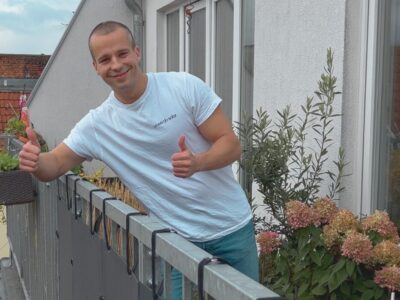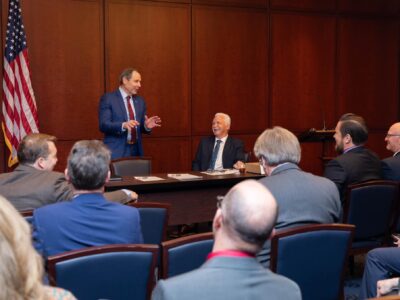Small modular nuclear reactors are emerging as an alternative to a fossil-fuel energy system. Nuclear power is considered the cleanest of all the renewable energy sources, producing steam as its only byproduct when burned. Other issues are associated with nuclear power, but climate experts agree it will play a more significant role in decarbonizing global energy systems.
The biggest question lately is sourcing uranium for small modular reactors (SMRs). LIS Technologies believes it has an effective method. The company uses laser technology to separate isotopes of uranium from infrared wavelengths.
Laser Isotope Separation, for which LIS is the acronym, can be applied to laser uranium enrichment and carries environmental benefits over fossil fuel or traditional uranium enrichment. The United States-based firm says it is opening “additional opportunities” for nuclear power needs for the U.S. naval fleet for High-Assay Low Enriched Uranium (HALEU). This type of uranium is the most common in SMRs and scientific research.
The company was founded in 2023 by Dr. Jeff Eerkens and Christo Liebenberg. The two were pioneers of the CRISLA process, the laser isotope enrichment tech that is “scalable, efficient, and cost competitive.”
CRISLA stands for Condensation Repression Isotope Separation by Laser Activation. LIS says this process is more advantageous than diffusion or centrifugal enrichment because it’s cheaper and optimized for low enriched uranium (LEU) and HALEU.

Photo Courtesy LIS Technologies
Eerkens innovated CRISLA in the 1970s, and his story is particularly interesting. He was born in Indonesia when it was still the Dutch East Indies and was interned as a 10-year-old child by the Japanese in Java during World War II. After the war ended following the atomic bombings of Hiroshima and Nagasaki, he was repatriated to the Netherlands to complete his education. He studied nuclear engineering at the University of California, Berkeley, and earned his doctorate in engineering science in 1960.
Liebenberg began studying lasers and optical applications in the 1980s. He worked at the Atomic Energy Corporation of South Africa, spearheading Molecular Laser Isotope Separation for enrichment. He received his master’s in physics from Stellenbosch University in South Africa and has co-authored around 10 patents and multiple technical papers. He and Eerkens founded CRISLA, Inc. in 2020 before establishing LIS.
“The CRISLA process takes a different approach and uses laser systems with significantly less complexity than any of the previous attempts at laser enrichment,” Liebenberg told The Business Download.
“In fact, the architecture of these laser systems align better with those used in the automotive industry, where industrial lasers have been used for decades for sheet metal cutting, welding, and drilling.”

Photo Courtesy LIS Technologies
According to the company, the CRISLA process is also much better for reduced energy consumption, produces less byproduct from uranium enrichment due to its precision, and has a higher enrichment rate for HALEU. The problems associated with laser enrichment are scaling, capital costs, and proliferation concerns.
Both founders are huge nuclear power advocates and believe their laser technology could significantly improve renewable energy systems.
The company recently completed a $12 million funding round for its laser uranium enrichment. A new facility will help the company isolate Uranium-235, the isotope commonly used in nuclear energy systems. John M. Shimkus, a former Illinois congressman, recently joined the firm as the Chair of Energy Policy and Retired USMC Gen. John M. Paxton as its executive chair of military and defense.
“Recent geopolitical events have made it clear that it is no longer prudent to depend primarily on foreign governments for the critical resources needed in nuclear energy,” Paxton said in his official announcement. “LIST, a U.S.-based company headquartered in the cradle of America’s nuclear history, is poised to play a significant role in ensuring the United States remains a global leader in the nuclear energy sector, thanks to its innovative technology and forward-thinking management.”
“By all metrics, Laser Isotope Separation is a better method for harvesting isotopes for nuclear power because of its higher efficiency, lower energy consumption, smaller environmental footprint, suitability to produce HALEU fuel for SMRs, and its potential to fuel advanced reactors,” Liebenberg explained.
“However, the technology is still in development, and widespread adoption depends on overcoming technical, economic, and regulatory challenges.”

Photo Courtesy LIS Technologies
LIS is currently working on a Tennessee enrichment facility, which is part of its Roadmap to Commercialization. Oak Ridge, Tennessee, will be the site of the laser research facility. Once all necessary steps have been taken, it could start producing uranium by the 2030s. By then, the global energy supply will likely have steered closer to tripling its renewable energy capacity, the goal set by world leaders at COP28.
“Laser Isotope Separation, or just Laser Enrichment as it’s sometimes referred to, has been around for more than 50 years, investigated by ~25 countries, and has always been seen as the ‘Holy Grail’ of isotope harvesting, with uranium enrichment one of its main applications,” Liebenberg said. “While it is not yet the dominant method in commercial use, LIS offers several advantages over traditional enrichment technologies.”





